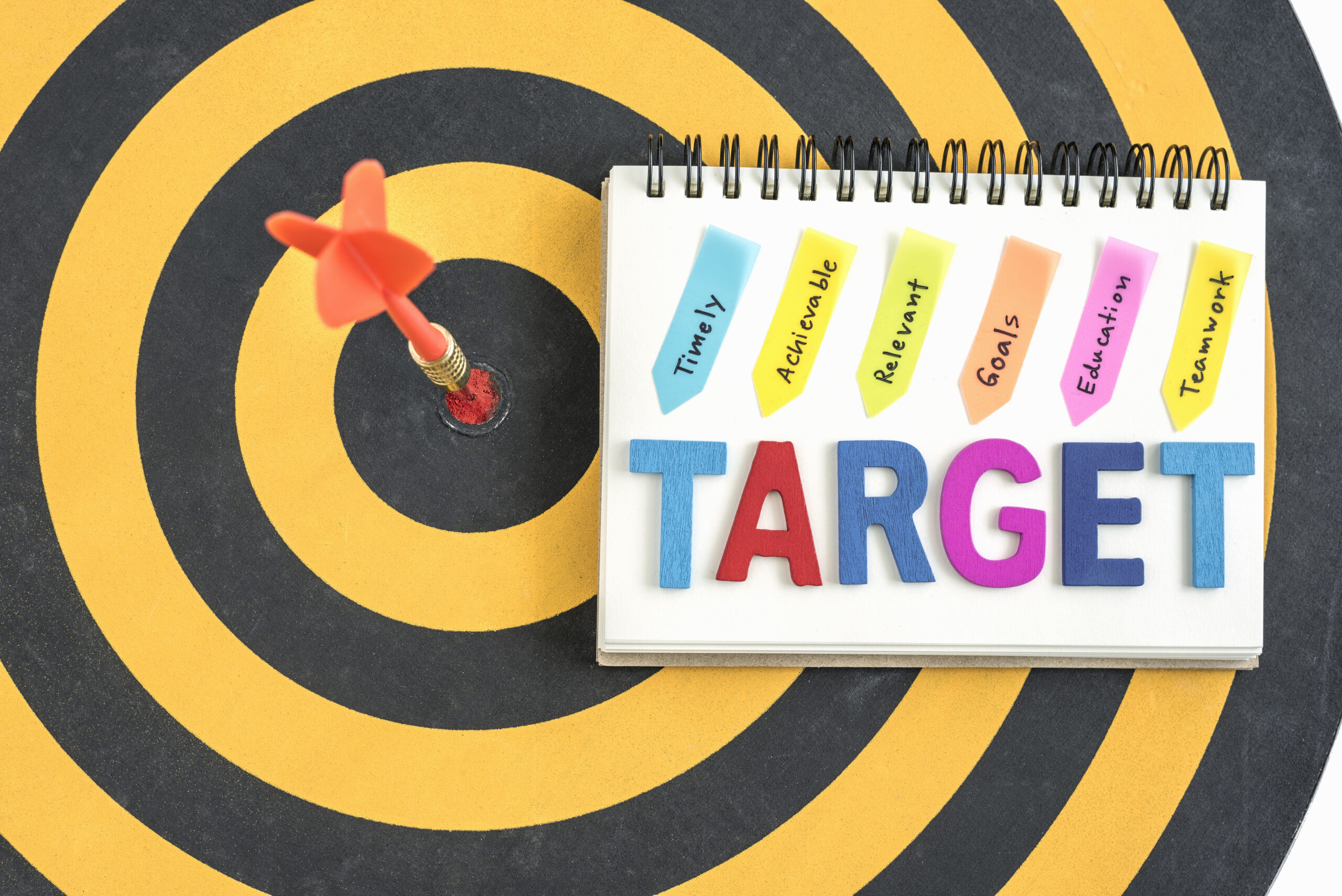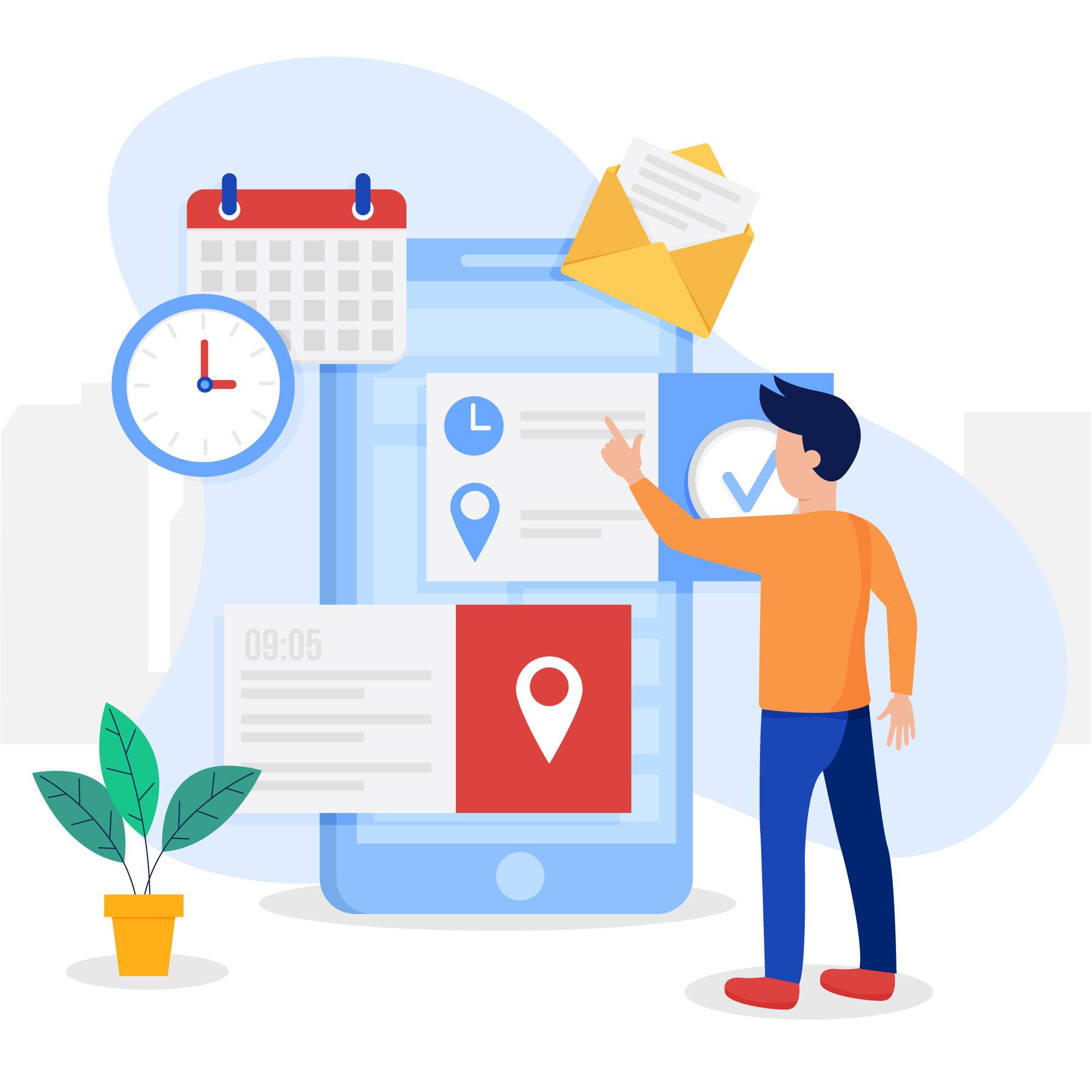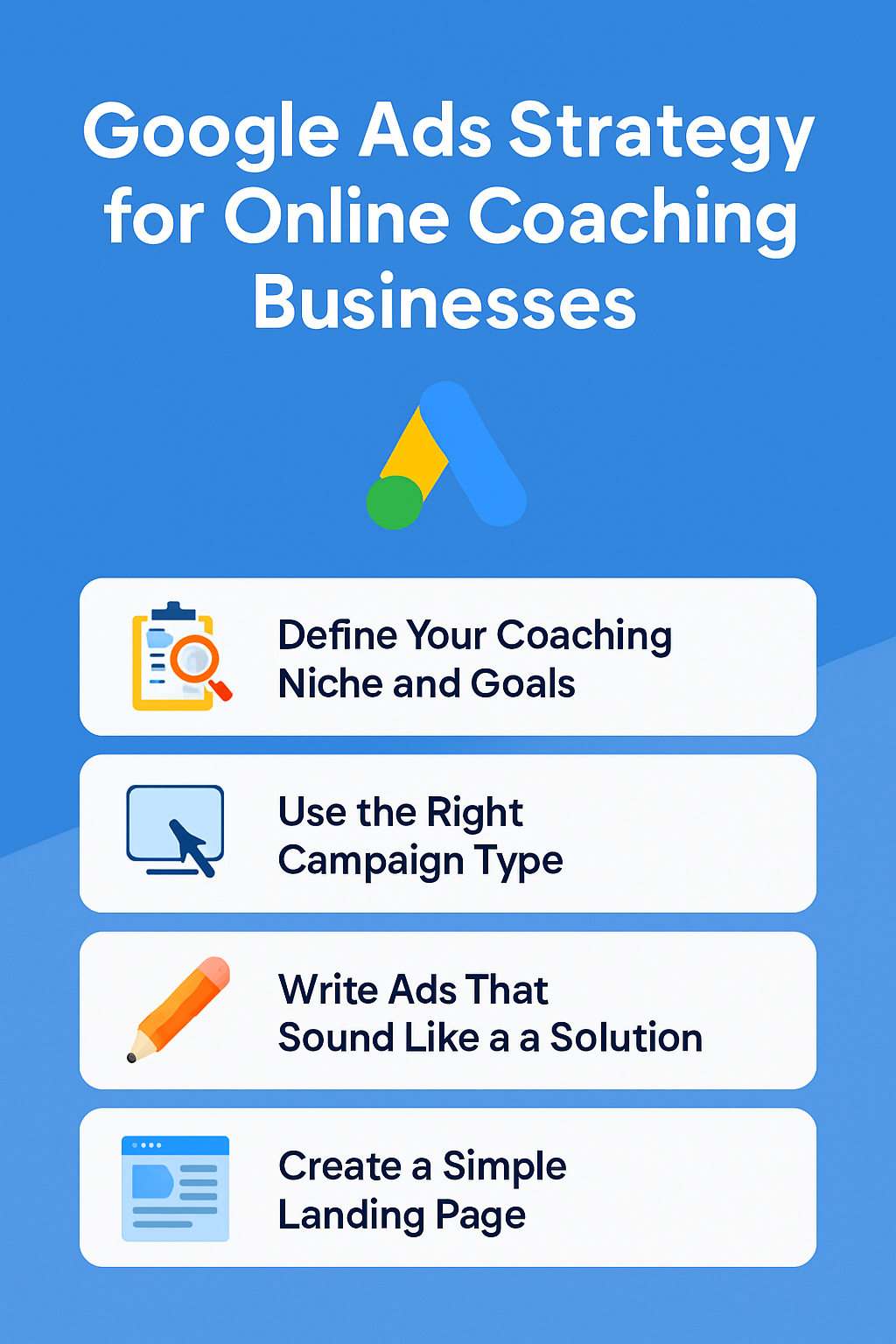Online coaching businesses are growing fast. From fitness and career coaching to language learning and life guidance, people are turning to online platforms to learn new skills.
However, with increased competition, it is no longer enough to rely only on organic reach or word-of-mouth.
Google Ads can play a strong role in reaching the right audience and increasing enrollments.
In this article, we will walk through a complete strategy for running Google Ads for online coaching services.
Effective Google Ads Strategy to Grow Your Online Coaching Business
Here is a step-by-step guide to help your online coaching business grow using Google Ads.
Learn how to reach the right audience and turn clicks into clients.
1. Identify Your Main Business Objective
Before starting any Google Ads campaign, it is important to understand exactly what your business aims to achieve.
Some coaching businesses want more consultation bookings, while others are focused on selling digital courses or growing email lists.
Each goal requires a different ad approach. When you define one specific objective, it becomes easier to select the right ad settings, keywords, and landing page content.
For example, if your goal is to get sign-ups for a webinar, the ad should include messaging that guides the user directly to a registration page.
On the other hand, if you want to generate qualified leads, the focus may shift to a form that collects names, emails, and interests.
Goals also help you measure success. Without a clear direction, it becomes difficult to track what is working and what needs improvement.

2. Choose the Most Effective Campaign Type
Many online coaches waste money by choosing the wrong type of Google Ads campaign. Understanding how each type works is essential.
Search campaigns are often the best starting point because they respond to what users are actively searching.
These ads appear when someone enters a phrase such as “online public speaking coach” or “fitness trainer for beginners.”
Display campaigns show image-based ads across websites. These are good for awareness, but not always ideal for sign-ups.
Video campaigns on YouTube work well when you want to build trust through visual content like lesson previews or testimonials.
Another option is Performance Max, which uses automation to display your ads across multiple platforms.
However, this requires enough data and a well-structured funnel. Choosing the right campaign depends on your budget, content, and readiness.
3. Focus on Specific and Intent-Based Keywords
Selecting the right keywords can make or break your campaign. Rather than choosing broad terms that may attract the wrong audience, go for specific phrases that reflect clear intent.
People who search for “one-on-one language coaching online” are more likely to convert than those searching for “language learning.”
Using exact match or phrase match keyword types helps in showing your ads to the right people.
You can use tools like Google Keyword Planner to discover keywords that have decent search traffic and aren’t too competitive.
Do not forget to include negative keywords such as “free” or “jobs” to block unwanted traffic.
This improves your ad quality and lowers costs. The aim is not to get more clicks but to get the right clicks.
4. Set Location and Time Filters Based on Your Audience
Your ads should only appear where and when they are most relevant.
If you offer coaching to people in specific countries or regions, use location targeting to avoid wasting your budget.
For example, if your services are limited to English-speaking countries, there is no reason to show ads in places where your language is not spoken.
In addition to location, schedule your ads during hours when your audience is most likely to search.
Professionals might browse in the evening or on weekends. Parents may prefer mid-morning after school drop-offs.
These settings help increase the chance of meaningful engagement. Running ads at all times often leads to higher spending with fewer results.

5. Build Clear and Goal-Oriented Landing Pages
Sending users to a general homepage is one of the most common mistakes. A dedicated landing page allows you to control the experience and focus entirely on one goal.
If your ad promises a free trial lesson, the landing page must deliver on that promise without distractions.
Start with a headline that directly addresses the visitor’s need. Use supporting text to explain what the user will get and how your coaching can help.
Add visual elements like photos or short videos to build trust. Include a testimonial if available.
Most importantly, place a single call-to-action, such as a sign-up form or calendar booking button, in a visible position.
Keeping the page simple and focused will increase the chances of conversion.
6. Track Conversions to Measure Real Results
Measuring your campaign’s impact is critical to making better decisions.
Without proper tracking, you may continue spending money without knowing what is or is not working.
Google Tag Manager and Google Analytics allow you to track user actions, such as form submissions or clicks on contact buttons.
By monitoring these actions, you can learn which ads and keywords are driving real interest.
Conversion tracking also helps Google improve your campaign by learning what results you want.
If a particular keyword brings in high-quality leads, you can allocate more budget to it.
Tracking should be part of your setup before the campaign even begins.
7. Set Budgets and Bidding With a Testing Mindset
Budgeting is not only about setting limits but also about testing and learning. It’s a good idea to begin your campaign with a daily budget that’s easy to manage.
Watch how your ads perform for a few days before increasing the amount.
Your bidding strategy should match your goal. If your objective is lead generation, using a bidding method like “Maximize Conversions” might bring better results.
If cost control is important, consider using “Target Cost Per Action”. Avoid trying too many things at once. Focus on one campaign, monitor the results, and make small changes based on data.
This steady approach helps you scale up with confidence.

8. Write Simple and Clear Ad Copy With Useful Extensions
A strong ad starts with a headline that captures attention. Make sure your message clearly shows what you provide and why it’s worth choosing.
Avoid confusing or technical words. Keep the language simple, avoid jargon, and focus on the challenges your audience wants to solve.
Below your ad, you can add extensions that give more information. Callout extensions let you highlight benefits like “Free Call Included” or “Flexible Timings.”
Sitelinks can point users to other parts of your website, such as reviews, FAQs, or your bio. Call extensions make it easy for people to contact you directly from the ad.
These tools improve your ad’s visibility and give users more reasons to take action.
9. Bring Back Visitors Through Remarketing
Not every visitor converts the first time they see your website. This is where remarketing becomes valuable.
By targeting users who visited your site but did not sign up, you can remind them about your coaching offer. Often, people need more than one touchpoint before they take action.
Your remarketing ads can show special offers, success stories, or simply remind users that your slots are still open.
These ads help remind potential clients about your brand, especially those who have already shown interest.
Since they are more likely to convert, the cost of remarketing is usually lower, and the return can be higher.
10. Review Campaign Performance and Improve Weekly
Constant improvement is part of every successful ad campaign. Checking your account once a week helps you spot patterns, fix mistakes, and find new opportunities.
Look at which keywords bring results, which ads get the most clicks, and which landing pages lead to conversions.
If something is not working, make small adjustments instead of starting over.
Add negative keywords, change headlines, or update the call-to-action on your page.
Use the data to guide your changes. With time, these small updates can lead to better results without increasing your budget.

Google Ad Campaign Types for coaching businesses
Explore different Google Ad campaign types that help coaching businesses attract, engage, and convert their ideal clients. Each format serves a unique purpose to support your growth goals.
Search Campaigns
Running ads that appear directly on Google Search is one of the best ways to capture people who are actively looking for coaching help.
These users are already searching for solutions using specific words like “life coach near me” or “online career coaching.”
This campaign type brings your service in front of those who are ready to take action.
You’re charged only when someone clicks your ad, which helps you manage both your budget and performance effectively.
Display Campaigns
Using visual banners across different websites helps you reach a wide group of people who may not be searching right now but still fit your audience.
This type of campaign works well for increasing brand awareness and staying visible to potential clients.
You can add your photos, success quotes, or simple calls to action. It also allows you to follow people around the web after they visit your website.
YouTube Campaigns
Video ads placed before, during, or after YouTube videos can give your audience a better feel for your style and message.
This format allows coaches to show their personality, offer advice, or explain what their coaching covers.
People often trust faces more than plain words, and this campaign type takes advantage of that trust.
It also allows for low-cost views, especially when using a strong hook in the first few seconds.

Performance Max Campaigns
Combining all major Google ad placements into one campaign gives you full coverage without managing each platform separately.
This type uses your content, images, and video to find people most likely to become your clients.
Google handles where and when to show your ads. Many coaches with limited time or small teams choose this option for ease and better use of the budget.
Discovery Campaigns
Placing ads across platforms like Gmail, YouTube home, and Google Discover helps you catch attention while people are browsing.
These placements appear like regular content and feel natural in the user’s feed.
Discovery campaigns work well for promoting coaching freebies like ebooks or quizzes that get people into your sales funnel.
It is also a good fit for growing your email list or community.
Remarketing Campaigns
Following up with people who have already visited your coaching website helps increase your chances of turning visits into sign-ups.
These campaigns show your ads to past visitors as they continue browsing online.
You can use this to remind them about your services, offer a limited-time deal, or share a testimonial.
It works well because these people already showed some interest in what you offer.

Are you struggling to get quality leads for your coaching business?
If you are struggling to get quality leads for your coaching business, digital marketing might be the missing link.
BrandOut helps coaching businesses run focused Google Ads, build a strong online presence, and reach the right audience more effectively.
Final Thoughts
Online coaching businesses can reach the right students at the right time with the help of Google Ads.
The key is to use clear goals, smart keyword selection, focused landing pages, and data-based improvements. With this strategy, your coaching program can grow faster and reach more learners online.
Most Asked Questions;
What is the best Google Ads campaign type for new coaching businesses?
Search campaigns are ideal for new coaching businesses because they target users actively searching for solutions.
This helps you appear right when potential clients are looking for coaching.
It’s focused, cost-effective, and high-intent.
How much should I spend on Google Ads for my coaching business?
Begin with a daily budget of $10–$20 to test what works.
Monitor results closely for 1–2 weeks before increasing your spend.
Scale up only if you’re getting quality leads or conversions.
How do I know which campaign type is working best?
Check metrics like conversions, CTR, and cost per lead.
The Google Ads dashboard gives detailed reports for each campaign.
Compare data weekly to understand what’s performing better.
Should I use Performance Max for my coaching business?
Performance Max is useful if you want a broader reach.
It runs ads across YouTube, Search, Gmail, and Display.
Just make sure your creatives and targeting are well-optimized.




